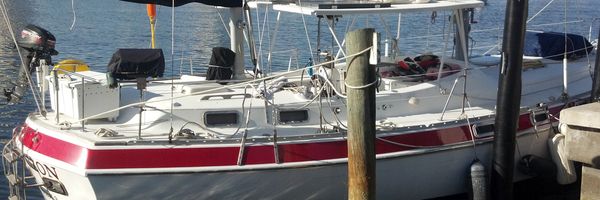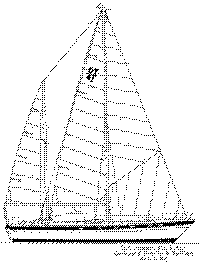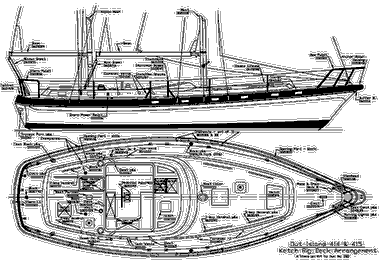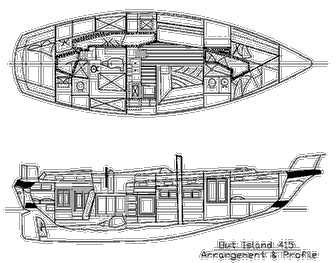

| Blog | About | Projects | Systems |
|---|---|---|---|
| Horizon's Track | Cate's site | Links |
In 1997 I started this site on returning from a 5-year cruise
from San Francisco to Tampa and while busily writing
WXTide32, our free world-wide tides program.
Time passed, then in 2010 after
24 years of ownership, that Rafiki 35 named Horizon
was sold. Shortly after that Cate and I bought this Morgan 415, made it our
new home and began her refit. By this time svHorizon had become an integral
part of life so it was an easy decision to change our new boat's name from
Enchanter/Capricious to Horizon.
 (Click for old site)
(Click for old site)
Almost two years late, I finally restarted updating this site. Please don't expect frequent updates though - for the most current news please see our blog.
| Type: Sail-Cruising, full keel, center cockpit | LOA: 41' 3" |
| Year built: 1979 | LOD: 41' 3" |
| Builder: Morgan | LWL: 34' |
| Hull: Fiberglass | Beam: 13' 10" |
| Model: Out Island 415 | Draft: 4' 2" |
| Rig: Ketch | Fuel: 140 gallons diesel |
| Displacement: 27,000 lbs | Water: 170 gallons in 2 tanks |
| Ballast: 9,000 pounds | Engine: 60 HP Perkins Prima M60 |
Morgan 415 ketch layouts:
 Profile and Sail Plan
Profile and Sail Plan
 Deck Layout
Deck Layout
 Interior Layout
Interior Layout
(opens Picasa album in new window):
|
(opens Picasa album in new window):
|
Below are most all of our projects to date for Horizon loosely grouped into categories. As we write more about items they will turn into links that will click through to the description.
Our on-board hamster is Mike, N6ULB, with an amateur Advanced Class ticket. We totally took the simple route and got the Sea Tech Communicator package that had everything needed for an HF radio communications system. The ICOM 802 is an HF radio legal for use on both ham and Marine SSB bands and, while it is very functional for either use, it does lack easy access to some of the useability features hamsters are used to like squelch, noise blankers, etc. With the Pactor III modem and a laptop, it handles email nicely via Winlink (ham/non-commercial) or SailMail (SSB/business) BBS systems. Our last boat had a manual antenna tuner and dedicated antenna and ground systems that took a great deal of care, effort and time to assemble and install. This time I chose more pre-packaged products with GAM split lead antenna that slides up an existing shroud, a sealed tube KISS SSB ground system that is draped along the inside of the hull, and an ICOM auto antenna tuner. The radio seems happy and shows the tuner is getting surprisingly low SWR. As we get experience with the system away from the dock and other boats, we will let you know how it performs.
Sat phone
The GSP-1700 satellite phone uses the GlobalStar system which has had its share
of problems - coverage is not continuous and has varying windows of satellite
visibility ranging from a few minutes to most of an hour. Because of the
coverage problem, GlobalStar is offering a good lock-in rate for a year of $40
per month for their
Evolution II
plan with unlimited voice, text, and data. That easily beats the $1-$2 per
minute with the other carriers. Call quality is crystal clear while the
satellite is well above the horizon. For missed calls, incoming voice messages
can be left anytime and we will get them when next we connect. Unfortunately
incoming text messages seem to be ignored if the phone is not connected at that
moment. Also our calls out do not send our caller ID so we will look like
telemarketers when we call.
GlobalStar does have a handy tool to calculate satellite visibility. A sample for Tampa on 9/25/2012:
Start End Duration
09:03:46 AM 09:28:46 AM 25 min 0 sec
09:33:06 AM 09:48:36 AM 15 min 30 sec
09:54:26 AM 10:28:36 AM 34 min 10 sec
Email and Data
We can handle email with either the sat phone or the ham radio with the caveat
that data speeds are really really slow. Both the Pactor III modem on the ham
radio and the sat phone transfer data at a, ahem, blistering 9600 baud in the
best case. That is 9,600 bits per second in a world where my Galaxy Nexus cell
phone sees 4,000,000 bits per second! Needless to say, we will not be surfing
the web while at sea. Using email we can get GRIB wind and weather forecast
files from
Saildocs
and the ham radio can also receive Weather Fax. All that should help bolster
the weather forecasting skills we learned in the USPS weather class :)
SPOT on!
The
Delorme inReach communicator and the
SPOT GPS Messenger
are intriguing. The features we most like are the ability to send "We are fine
and here is where we are" messages at any time and to also maintain a breadcrumb
trail of our travels that can be viewed online. While the inReach has a lot of
interesting features including message confirmation and two-way texting, for
what we need we are leaning toward the SPOT Messenger with its lower
subscription rate of $100 per year.
UPDATE (12/12): We did get the SPOT after all.
Bullet WiFi
We picked up a
Bullet M2HP
WiFi radio and a SS omni-directional antenna that should give us a pretty
significant WiFi reach. When in port, from an anchorage we hope to be able to
pick up WiFi connections from on-shore hot spots. Unfortunately we keep hearing
that more and more WiFi connections are going secured so the system may not be
that useful for us. Well, unless we sidle up and make friends with the locals
and garner a password or two.
Snail mail
We decided to go with
St. Brenden's Isle
service to take care of our mail forwarding and other home port needs such as
USCG documentation renewals. We especially like the option they offer that
scans mail covers so that online we can pick which mail to have forwarded to us,
or have opened and the contents scanned, or which ones to shred.
VPN
We still haven't decided which service to use for this either but the thinking
is a paid provider might be safest. All we know is that securing internet
communications across the public systems we will be using will probably have
huge safely benefits.
Power generation
We have two eco-friendly ways to maintain power for the toys: solar panels and
wind generator. One great feature of a hard dodger is it gives a huge flat area
for mounting stuff. We used about half that area when we mounted two 240 Watt
solar panels up there. I started to do a real analysys of wattage per size and
which ones were likelier to hold up under the marine environment. ... then I
whimped out and went with cost per watt figuring the solar panel market is
likely to really change quickly as the world comes to rely less on fossile
fuels. We settled on the model HiS-S240MG made by Hyundai because they were
only 1.4" thick instead of 2" normal, and they were at a cost point of only
$1.35 per watt. Thickness is a factor since the main boom swings just above
them. The panels are 30 volt so the Blue Sky MPPT controller was needed to keep
from wasting 1/3 of the total power. The four individual #10 wires come down
the inside one of the dodger support tubes so it is a neat installation. Inside
the cabin are diodes to isolate the two panels so if one gets shaded the other
will continue to function.
We also have an older model Rutland 913 wind generator. It does not put out as much raw power as some newer units but it kicks in at lower wind speeds than most and is almost silent while operating. We have it mounted on the mizzen on a KISS wind generator mount with a rubber isolated mounting tube tall enough that the wind generator swivels 360 degrees. We do have one problem in that we do not yet have steps on the mizzen to be able to quickly scamper up and tether the blades for major storms.
The solar panels feed into a Blue Sky MPPT charge controller and the wind generator is wired through its own controller. If we are lucky enough to have excess power, the solar controller has a diversion output connected to an auxillary 12V element in the water heater.
Energy budget
With wind and solar power we expect to harvest between 150-180 Amp Hours per day
when it is sunny and only moderately breezy. So unless we want to run the
engine to top up batteries, that is the target we hope to keep under with all
the energy draw devices.
Our pre-cruise estimated daily Amp Hour consumption is:
60 Adler Barbour built-in fridge, 5 amps runs about half the time
60 Adler Barbour upright fridge with the same Danfoss compressor
45 Isotherm DR-55 freezer specs say average 1.5 amps but we rounded up
18 Watermaker, 12 amps running 1.5 hours a day
10 Ham radio
20 Torqeedo outboard battery charging
20 Pumps, lights, sundries
--------------------------
173 AHs per day estimated total usage
It looks like we will be running a deficit unless the wind is really blowing so
we may end up running the engine a few hours a week after all. We do have
options though - for example found we really will have little need to run the
upright refrigerator now that we have dedicated the build-in to just fridge and
the dedicated drawer freezer. (We really like not having to defrost either :) It
is still early days though and this is only an estimate. We will refine these
nunbers as we get more time on the hook.
Our criteria for estimating cruising expenses are rather specific. We expect to be on our own anchor most all of the time which greatly reduces, but does not totally eliminate, outlays for dock fees and moorage - we will still have to put in once in a while and we hear that dinghy dock fees can be quite high. With so much new gear we hope that there should be a few years with less major breakage of things that we will find critical and anything that does break will hopefully be fixable using on board spare parts. Many of the "toys" we are leaving with at the start are obviously non-essential and when they break, we will likely not be beating a path to the shop to fix or replace them. Only time cruising will tell just which things we will continue to find critical and which will become less essential. We are certainly not expecting to give up much during our traveling retirement beyond being tied to a dock for long periods of time and having the luxury of instant internet access. Okay, I think constant internet access we will miss the most :)
Horizon's monthly cruising budget categories:
Boat maintenance/fuel
Dockage/customs/charts
Groceries
Restaurants
Transportation (bus, cab, occasional moped)
Entertainment
Misc medical (medicine, doctor/dentist visits)
Satphone Evolution II (inc tax and fees)
SPOT GPS Messenger ($100/yr)
St. Brenden's Isle mail forwarding
Miscellaneous (ice cream, shoes)
To these day-to-day expenses we have to add a sizeable chunk for insurance of various types and, of course, taxes to the feds. While we have obviously made an attempt to estimate each of these expenses, I am not going to publish them just yet. We might do that later.
HundredZeros.com - Cruising involves a great deal of leisure time and reading books can help keep you occupied. This site lists all the Kindle books Amazon is currently offering for free. Amazon changes that catalog frequently so check back often to see what is on the list that day. I have downloaded about 40 books so far and use the Kindle app on my Galaxy Nexus Android phone.
FreeCruisingGuides.com - Lots of good info and free cruising guides for the Caribbean.
OpenCPN.org - Free open source chart plotting and navigation software that supports many chart formats including the free NOAA raster and vector charts.
SSCA.org
- I have been a member of Seven Seas Cruising Association since about 1985. I
always used to say "I would never join a group that would have me as a member"
but the SSCA is my exception. They are an excellent resource for info and ideas
and the GAMs and seminars are the best. We rarely miss the monthly SSCA
breakfast meetings here in St. Petersburg.
This page last updated March 2017.